Background
Matilda Lawrence was both the mulatto daughter and the slave of Larkin Lawrence, a Missouri planter. Matilda's mulatto mother, also a slave, raised her while serving as housekeeper on the Lawrence estate. Upon her mother's death, the 16-year-old Matilda assumed the duties of housekeeper. [4] [5] [6]
In 1836, Larkin Lawrence traveled with 19-year-old Matilda to the free state of New York for an extended visit. As Matilda was a "light mulatto" he successfully presented his daughter/slave - "of striking beauty and engaging manners" - as his white offspring, concealing her servile status in Missouri. [7] [8] [9] When Matilda implored her master-father to provide documents freeing her, he refused and made haste to return with her to Missouri. Stopping en route in Cincinnati, Ohio, Matilda fled secretly into the city when her owner rejected a final plea for freedom. Her whereabouts was concealed by local abolitionists until her owner-father departed Cincinnati several days later. [10] [11]
Believing she had secured her independence, Matilda found work as a housekeeper with the well-known anti-slavery activist James G. Birney. A former slave owner, Birney was publisher for the abolitionist journal The Philanthropist . Birney claimed that he was unaware of Matilda's ancestry when he hired her, as she had divulged little about her personal history and appeared to be white. [12]
Unbeknownst to Matilda or Birney, Larkin Lawrence had engaged a slave catcher, John W. Riley, to effect Matilda's capture and return to Missouri. After a lengthy surveillance of the Birney residence, Riley and his associates obtained a warrant for Matilda's arrest and took her into custody on March 10, 1837. [13] [14]
Birney quickly enlisted Cincinnati attorney and abolitionist Salmon P. Chase who had successfully represented the publisher in 1836 after an anti-abolitionist mob attacked the offices of The Philanthropist. Chase immediately demanded a writ of habeas corpus for the release of the jailed Matilda. Birney, in turn, had been charged with harboring an escaped slave in his home. The cases were handled separately by the courts. Birney and Chase collaborated closely in preparing their legal defense. [15] [16] [17] [18]
Legal case
John W. Riley's affidavit submitted to a local magistrate called for the arrest and detention of Matilda, stating simply that she was the property of Larkin Lawrence and that she had escaped from his custody while in Cincinnati. The magistrate added that Matilda was "a colored girl". [19]
Challenging the legitimacy of the affidavit, Chase offered a number of broad and wide-ranging legal arguments in court, invoking the Somerset principle, [20] The Fugitive Slave Act of 1793, the Northwest Ordinance, and the free-state statutes of Ohio. As Matilda had not fled her master from a slave state to a free state, Chase argued that no violation of Fugitive Slave Law had occurred. Chase asked the court to consider the ramifications of the case "where any person can be dragged, by any other person who chooses to set up a claim against him as a fugitive servant" in which local authorities would determine whether the individual would be reduced to a form of property. [21] [22]
Chase made a "tactical" error in failing to emphasis the circumstances of Matilda's "escape" from her "master": in voluntarily bringing his slave to Ohio, Larkin Lawrence arguably forfeited his Missouri-established right of property in Matilda. [23] The defense failed to convince the presiding Judge David Kirkpatrick Este. Deciding for the plaintiff, he reaffirmed the constitutionality of the Fugitive Slave law. Matilda was instantly seized by Riley's associates and carried back into slavery, "her ultimate fate unknown". [24] [25] [26]
The pamphlet that Chase issued on the case entitled "The Colored Woman, Matilda" (1837) set forth his legal arguments and was widely circulated. The case attracted many freed slaves to Cincinnati, many of whom many Chase defended in court cases, and earning him the sobriquet "attorney general for the fugitive slaves". [27] [28] [29]
Birney phase
James G. Birney was sued for allegedly violating Larkin Lawrence's property rights in violation of the constitutionally sanctioned Fugitive Slave Act. In Birney's defense, Chase maintained that the state of Ohio provided no statutes establishing property rights in persons held to service, nor the US Constitution, which defined slaves as "persons", not property. As such, he had committed no crime. [30] [31] Birney was found guilty in the lower court and he appealed to the Ohio Supreme Court. There Chase relied less on his constitutional arguments and more on Birney's testimony that he was not aware of Matilda's slave status in Missouri, nor that her departure from her father from the northern shore of the Ohio River never established fugitive status for his employee. The court reversed Birney's conviction on a technicality without addressing the constitutional issues raised by Chase. [32] [33]

The Underground Railroad was a network of secret routes and safe houses established in the United States during the early to mid-19th century. It was used by enslaved African Americans primarily to escape into free states and from there to Canada. The network, primarily the work of free African Americans, was assisted by abolitionists and others sympathetic to the cause of the escapees. The slaves who risked capture and those who aided them are also collectively referred to as the passengers and conductors of the "Underground Railroad". Various other routes led to Mexico, where slavery had been abolished, and to islands in the Caribbean that were not part of the slave trade. An earlier escape route running south toward Florida, then a Spanish possession, existed from the late 17th century until approximately 1790. However, the network now generally known as the Underground Railroad began in the late 18th century. It ran north and grew steadily until the Emancipation Proclamation was signed by President Abraham Lincoln. One estimate suggests that, by 1850, approximately 100,000 slaves had escaped to freedom via the network.

Abolitionism, or the abolitionist movement, is the movement to end slavery and liberate enslaved people around the world.

Salmon Portland Chase was an American politician and jurist who served as the sixth chief justice of the United States from 1864 to 1873. He had earlier served as the 23rd governor of Ohio, and had also represented Ohio in the United States Senate, and had served as the 25th United States Secretary of the Treasury in the administration of Abraham Lincoln. Chase is therefore one of the few American politicians who have served in all three branches of the federal government, in addition to serving in the highest state-level office. Prior to his Supreme Court appointment, Chase was widely seen as a potential president.
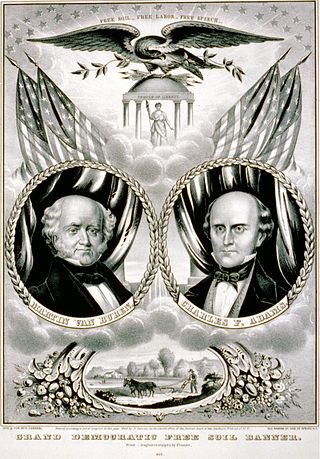
The Free Soil Party was a short-lived coalition political party in the United States active from 1848 to 1854, when it merged into the Republican Party. The party was largely focused on the single issue of opposing the expansion of slavery into the western territories of the United States.
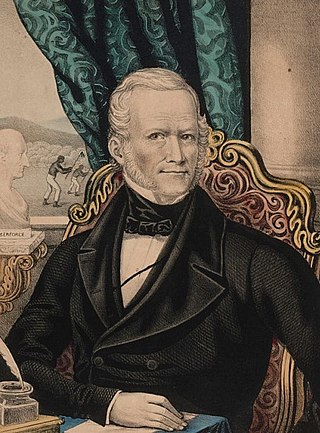
James Gillespie Birney was an American abolitionist, politician, and attorney born in Danville, Kentucky. He changed from being a planter and slave owner to abolitionism, publishing the abolitionist weekly The Philanthropist. He twice served as the presidential nominee for the anti-slavery Liberty Party.

The Fugitive Slave Act or Fugitive Slave Law was a law passed by the 31st United States Congress on September 18, 1850, as part of the Compromise of 1850 between Southern interests in slavery and Northern Free-Soilers.

Thomas Morris was an American politician from Ohio who served in the United States Senate and was a member of the Democratic Party. In the 1844 presidential election, he was the vice presidential nominee of the anti-slavery Liberty Party.

Levi Coffin was an American Quaker, Republican, abolitionist, farmer, businessman and humanitarian. An active leader of the Underground Railroad in Indiana and Ohio, some unofficially called Coffin the "President of the Underground Railroad," estimating that three thousand fugitive slaves passed through his care. The Coffin home in Fountain City, Wayne County, Indiana, is now a museum, sometimes called the Underground Railroad's "Grand Central Station".
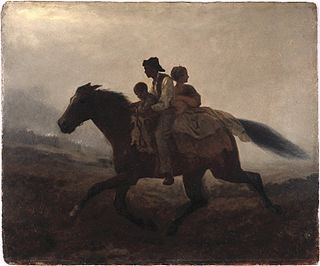
In the United States, fugitive slaves or runaway slaves were terms used in the 18th and 19th centuries to describe people who fled slavery. The term also refers to the federal Fugitive Slave Acts of 1793 and 1850. Such people are also called freedom seekers to avoid implying that the enslaved person had committed a crime and that the slaveholder was the injured party.

John Rankin was an American Presbyterian minister, educator and abolitionist. Upon moving to Ripley, Ohio, in 1822, he became known as one of Ohio's first and most active "conductors" on the Underground Railroad. Prominent pre-Civil War abolitionists William Lloyd Garrison, Theodore Weld, Henry Ward Beecher, and Harriet Beecher Stowe were influenced by Rankin's writings and work in the anti-slavery movement.

Margaret Garner, called "Peggy", was an enslaved African-American woman in pre-Civil War America who killed her own daughter rather than allow the child to be returned to slavery. Garner and her family had escaped enslavement in January 1856 by traveling across the frozen Ohio River to Cincinnati, but they were apprehended by U.S. Marshals acting under the Fugitive Slave Act of 1850. Garner's defense attorney, John Jolliffe, moved to have her tried for murder in Ohio, to be able to get a trial in a free state and to challenge the Fugitive Slave Law. Garner's story was the inspiration for the novel Beloved (1987) by Nobel Prize-winning author Toni Morrison and its subsequent adaptation into a film of the same name starring Oprah Winfrey (1998).
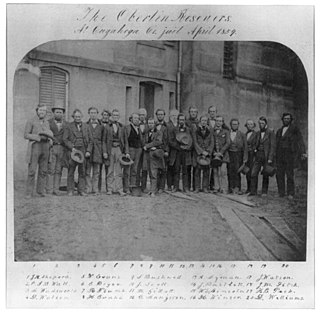
The Oberlin–Wellington Rescue of 1858 in was a key event in the history of abolitionism in the United States. A cause celèbre and widely publicized, thanks in part to the new telegraph, it is one of the series of events leading up to Civil War.
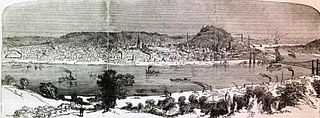
During the American Civil War, the Ohio River port city of Cincinnati, Ohio, played a key role as a major source of supplies and troops for the Union Army. It also served as the headquarters for much of the war for the Department of the Ohio, which was charged with the defense of the region, as well as directing the army's offensives into Kentucky and Tennessee.

The Liberty Party was an abolitionist political party in the United States prior to the American Civil War. The party experienced its greatest activity during the 1840s, while remnants persisted as late as 1860. It supported James G. Birney in the presidential elections of 1840 and 1844. Other prominent figures connected with the Liberty Party included Gerrit Smith, Salmon P. Chase, Joshua Leavitt, Henry Highland Garnet, and John Greenleaf Whittier. The attempted to work within the federal system created by the United States Constitution to diminish the political influence of the Slave Power and advance the cause of universal emancipation and an integrated, egalitarian society.

The Underground Railroad in Indiana was part of a larger, unofficial, and loosely-connected network of groups and individuals who aided and facilitated the escape of runaway slaves from the southern United States. The network in Indiana gradually evolved in the 1830s and 1840s, reached its peak during the 1850s, and continued until slavery was abolished throughout the United States at the end of the American Civil War in 1865. It is not known how many fugitive slaves escaped through Indiana on their journey to Michigan and Canada. An unknown number of Indiana's abolitionists, anti-slavery advocates, and people of color, as well as Quakers and other religious groups illegally operated stations along the network. Some of the network's operatives have been identified, including Levi Coffin, the best-known of Indiana's Underground Railroad leaders. In addition to shelter, network agents provided food, guidance, and, in some cases, transportation to aid the runaways.
The Cincinnati riots of 1836 were caused by racial tensions at a time when African Americans, some of whom had escaped from slavery in the Southern United States, were competing with whites for jobs. The racial riots occurred in Cincinnati, Ohio, United States in April and July 1836 by a mob of whites against black residents. These were part of a pattern of violence at that time. A severe riot had occurred in 1829, led by ethnic Irish, and another riot against blacks broke out in 1841. After the Cincinnati riots of 1829, in which many African Americans lost their homes and property, a growing number of whites, such as the "Lane rebels" who withdrew from the Cincinnati Lane Seminary en masse in 1834 over the issue of abolition, became sympathetic to their plight. The anti-abolitionist rioters of 1836, worried about their jobs if they had to compete with more blacks, attacked both the blacks and white supporters.

In the United States, abolitionism, the movement that sought to end slavery in the country, was active from the late colonial era until the American Civil War, the end of which brought about the abolition of American slavery for non-criminals through the Thirteenth Amendment to the United States Constitution.
The Matson Trial (1847), officially Matson v. Ashmore et al. for the use of Bryant, was a freedom suit by former slave Anthony Bryant on behalf of his family in Coles County, Illinois. It is noted for the unusual circumstance where Abraham Lincoln, the future emancipator of slaves, defended a slave-owner against a slave. The case pitted Lincoln and former Illinois Attorney General Usher F. Linder against former US Representative Orlando B. Ficklin. Ficklin's case proved successful, and Bryant's family was emancipated based on free soil doctrine.
National conventions of the Free Soil and Liberty parties met in 1847 and 1848 to nominate candidates for president and vice president in advance of the 1848 United States presidential election. The conventions resulted in the creation of the national Free Soil Party, a union of political abolitionists with antislavery Conscience Whigs and Barnburner Democrats to oppose the westward extension of slavery into the U.S. territories. Former President Martin Van Buren was nominated for president by the Free Soil National Convention that met at Buffalo, New York on August 9, 1848; Charles Francis Adams Sr. was nominated for vice president. Van Buren and Adams received 291,409 popular votes in the national election, almost all from the free states; his popularity among northern Democrats was great enough to deny his Democratic rival, Lewis Cass, the crucial state of New York, throwing the state and the election to Whig Zachary Taylor.
Richard Eells (1800–1846) was an abolitionist and physician from Illinois. Born in Connecticut, he immigrated to Quincy, Illinois in 1833. A Yale College graduate, he set up a medical practice and quickly involved himself in abolitionism. His house became known as a place of refuge for escaped slaves.















